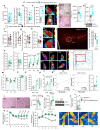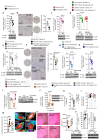Hypothalamic dopamine signaling regulates brown fat thermogenesis
- PMID: 31579887
- PMCID: PMC6774781
- DOI: 10.1038/s42255-019-0099-7
Hypothalamic dopamine signaling regulates brown fat thermogenesis
Abstract
Dopamine signaling is a crucial part of the brain reward system and can affect feeding behavior. Dopamine receptors are also expressed in the hypothalamus, which is known to control energy metabolism in peripheral tissues. Here we show that pharmacological or chemogenetic stimulation of dopamine receptor 2 (D2R) expressing cells in the lateral hypothalamic area (LHA) and the zona incerta (ZI) decreases body weight and stimulates brown fat activity in rodents in a feeding-independent manner. LHA/ZI D2R stimulation requires an intact sympathetic nervous system and orexin system to exert its action and involves inhibition of PI3K in the LHA/ZI. We further demonstrate that, as early as 3 months after onset of treatment, patients treated with the D2R agonist cabergoline experience an increase in energy expenditure that persists for one year, leading to total body weight and fat loss through a prolactin-independent mechanism. Our results may provide a mechanistic explanation for how clinically used D2R agonists act in the CNS to regulate energy balance.
Conflict of interest statement
The authors declare no conflict of interests.
Figures







References
-
- Palmiter RD. Is dopamine a physiologically relevant mediator of feeding behavior? Trends in neurosciences. 2007;30:375–381. - PubMed
-
- Mirmohammadsadeghi Z, Shareghi Brojeni M, Haghparast A, Eliassi A. Role of paraventricular hypothalamic dopaminergic D1 receptors in food intake regulation of food-deprived rats. European journal of pharmacology. 2018;818:43–49. - PubMed
-
- Fetissov SO, Meguid MM, Sato T, Zhang LH. Expression of dopaminergic receptors in the hypothalamus of lean and obese Zucker rats and food intake. American journal of physiology Regulatory, integrative and comparative physiology. 2002;283:R905–910. - PubMed
Publication types
MeSH terms
Substances
Grants and funding
LinkOut - more resources
Full Text Sources
Other Literature Sources

